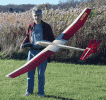Electronics Pioneers & History
- See Full List of AI Topics -
 Ernest Rutherford was a New Zealand physicist who is widely considered one of
the most significant scientists of the 20th century. He was born on August 30,
1871, in Nelson, New Zealand, and was the fourth of 12 children in his family.
Rutherford was a brilliant student and received a scholarship to attend
Canterbury College, where he obtained a Bachelor of Arts degree in Mathematics
and Physical Science. Ernest Rutherford was a New Zealand physicist who is widely considered one of
the most significant scientists of the 20th century. He was born on August 30,
1871, in Nelson, New Zealand, and was the fourth of 12 children in his family.
Rutherford was a brilliant student and received a scholarship to attend
Canterbury College, where he obtained a Bachelor of Arts degree in Mathematics
and Physical Science.
After graduating from college, Rutherford received a scholarship to study at
the University of Cambridge, where he worked under the guidance of J.J. Thomson.
Rutherford's research focused on studying the properties of radiation emitted by
uranium and other radioactive materials. In 1903, he discovered that radiation
consists of three types: alpha particles, beta particles, and gamma rays.
In 1908, Rutherford became the head of the physics department at the
University of Manchester, where he conducted his famous gold foil experiment. In
this experiment, Rutherford fired alpha particles at a thin sheet of gold foil
and observed the pattern of deflection of the particles. The experiment showed
that atoms have a small, positively charged nucleus at their center, which he
called the "atomic nucleus." This discovery revolutionized the field of atomic
physics and earned Rutherford the Nobel Prize in Chemistry in 1908.
Rutherford continued to make important contributions to physics throughout
his career. He discovered and named the proton, which is a subatomic particle
found in the nucleus of an atom. He also proposed the theory of radioactive
decay, which explains how radioactive materials break down over time.
Rutherford's work helped lay the foundation for nuclear physics, which has led
to numerous advancements in science and technology, including the development of
nuclear power.
In addition to his scientific achievements, Rutherford was also known for his
dedication to teaching and mentoring young scientists. Many of his students went
on to become prominent physicists in their own right, including James Chadwick,
who discovered the neutron, and Niels Bohr, who developed the theory of the
structure of the atom.
Ernest Rutherford died on October 19, 1937, at the age of 66. He is
remembered as one of the greatest scientists of all time, and his contributions
to the field of physics continue to be studied and built upon today.
This content was generated by the ChatGPT
artificial intelligence (AI) engine. Some review was performed to help detect and
correct any inaccuracies; however, you are encouraged to verify the information
yourself if it will be used for critical applications. In some cases, multiple solicitations
to ChatGPT were used to assimilate final content. Images and external hyperlinks
have also been added occasionally. Courts have ruled that AI-generated content is
not subject to copyright restrictions, but since I modify them, everything here
is protected by RF Cafe copyright. Your use of this data implies an agreement to
hold totally harmless Kirt Blattenberger, RF Cafe, and any and all of its assigns.
Thank you. Here are the major categories.
Electronics & High Tech
Companies | Electronics &
Tech Publications | Electronics &
Tech Pioneers | Electronics &
Tech Principles |
Tech Standards
Groups & Industry Associations |
Societal Influences on Technology
|








 Ernest Rutherford was a New Zealand physicist who is widely considered one of
the most significant scientists of the 20th century. He was born on August 30,
1871, in Nelson, New Zealand, and was the fourth of 12 children in his family.
Rutherford was a brilliant student and received a scholarship to attend
Canterbury College, where he obtained a Bachelor of Arts degree in Mathematics
and Physical Science.
Ernest Rutherford was a New Zealand physicist who is widely considered one of
the most significant scientists of the 20th century. He was born on August 30,
1871, in Nelson, New Zealand, and was the fourth of 12 children in his family.
Rutherford was a brilliant student and received a scholarship to attend
Canterbury College, where he obtained a Bachelor of Arts degree in Mathematics
and Physical Science. 